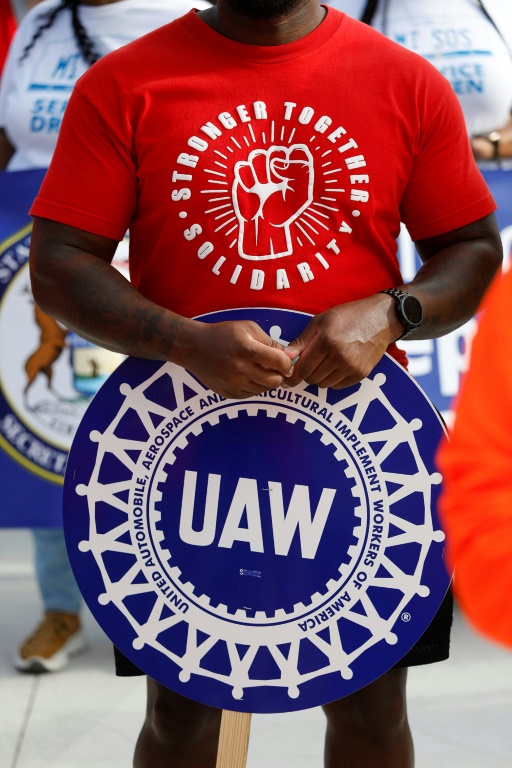The Detroit Auto Show, normally a cheery showcase of latest models from the three legacy US car giants, is taking second fiddle this year to a looming auto workers’ strike and its mounting odds.
The showcase kicks off one day before the Thursday night deadline when existing United Auto Workers (UAW) contracts at General Motors, Ford and Stellantis expire.
New UAW president Shawn Fain has for months vowed a tough approach to negotiations, demanding significant pay hikes in light of record profits and saying a strike could potentially extend to all three companies.
In recent days, Fain has acknowledged that automakers have begun negotiating in earnest, while criticizing the companies for leaving little time to hash out a deal.
The two sides have made “a little progress,” Fain told CNN on Monday night. “It’s still slow, but we’re moving.
“So you know we have a long way to go.”
Ford chief executive Jim Farley said Tuesday night that the two sides had made progress, but had “more to do.”
Speaking on the sidelines of a Ford event at the Detroit show, Farley said he was “still optimistic” of averting a strike, but that there are limits to what can be accepted and the company is “absolutely” ready for a strike.
Farley said Ford had earlier on Tuesday made a third offer to the UAW that he called the “most generous” in the company’s 80 years with the union.
The UAW represents about 150,000 workers at the three companies.
The economic impact of a strike would depend on its scope and length.
The worst-case scenario, a lengthy strike at all three companies, would dampen household consumption and prompt potential layoffs at auto suppliers, industry experts say.
Formerly held in January, the event, officially known as the North American International Detroit Auto Show, was rebooted as an autumn occurrence in 2022 with a primary focus on retail consumers.
It is meant in part to offer consumers a chance to get a closer look at electric vehicles (EVs), which are expected to become a bigger presence in the years ahead.
Ford kicked off this year’s proceedings with a Tuesday night celebration of its updated F-150 pickup truck, for decades the most popular vehicle in the United States.
GM and Stellantis are both set to host events Wednesday morning at Huntington Place, Detroit’s downtown convention center.
The show opens to the public Saturday, with a Wednesday kick off for the press.
But many in and around the auto industry are much more focused on the labor situation.
A note from JPMorgan Chase rated the strike odds as “high,” given the gulf between the negotiating parties and the union’s desire “to reclaim purchasing power lost to inflation… and to protect real wages from the potential for future increases in the cost of living.”
Fain has targeted a 40 percent wage increase commensurate with hikes in CEO pay in recent years.
Fain has also highlighted other worker priorities, such as job security during the transition to electric vehicles, an elimination of different pay levels among workers and better benefits for retirees.
President Joe Biden weighed in last month, saying the UAW “deserves a contract that sustains the middle class,” but urging “all sides to work together to forge a fair agreement.”
The company offers thus far have proposed wage increases between 10 and 14.5 percent.
Fain has been dismissive of such company proposals, calling the offers “insulting.”
While Fain’s tough tone opens the way for a possible strike, observers note that such a posture could also be a bargaining technique.
Labor watchers point to a recent UPS contract as a victory for Teamsters president Sean O’Brien, but one that came only after he blasted executives and made clear he was ready to strike.
“A fair amount of bargaining is theater,” said Harry Katz, a professor at Cornell’s School of Industrial and Labor Relations.
In any case, locals are beginning to organize concrete steps in case there is no deal by Thursday at midnight.
The website of UAW Local 600, which represents workers at Ford’s Dearborn truck plant, includes strike assignments to workers for the first seven days of a stoppage.
Picketing guidelines urge them to “peacefully” patrol near the factory fence and stress not littering or bringing alcohol to a picket site.
AFP

AFP





![DoorDash Driver Caught on Camera Spitting on Customer’s Food as Revolting Revenge after Being Given $3 Tip for Driving Half-a-Mile [VIDEO]](https://data.ibtimes.sg/en/full/69891/doordash-driver.jpg)
